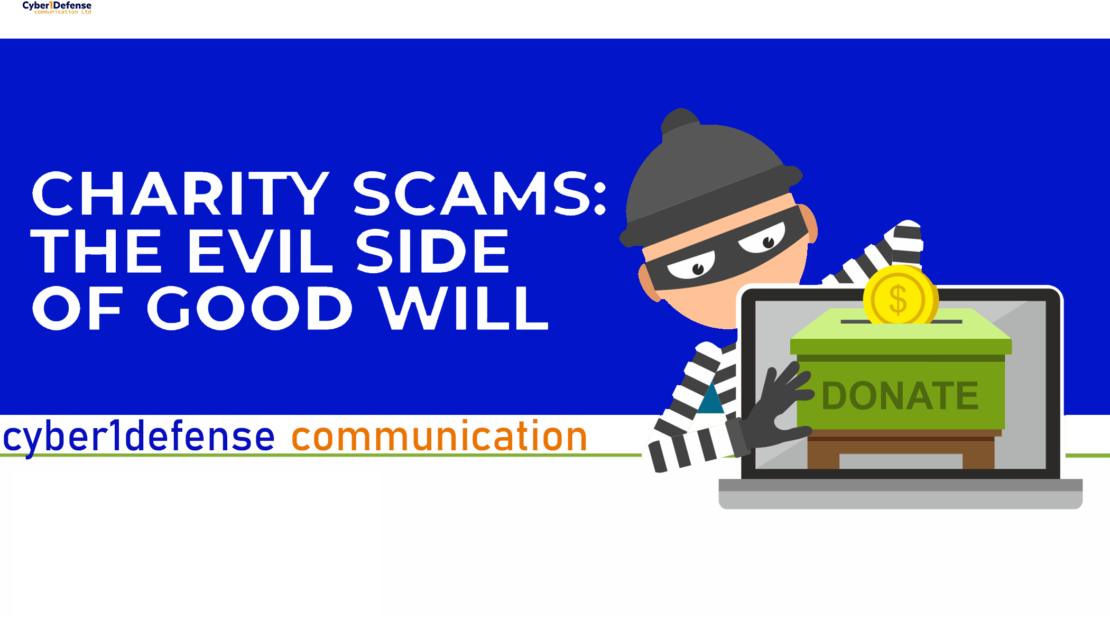[mc4wp_form id=”2320″]
Charity Scams
-
January 3, 2024
- Posted by: Evans Asare

charity scams: what is it, and how you can prevent yourself from it.
As the holidays approach, many of us are feeling the spirit of giving and looking for ways to spread cheer to those less fortunate. But beware! Scammers are lurking, ready to take advantage of good intentions. People give their gifts because they wish to see the world become a better place and, therefore, are dismayed to learn that their act of generosity has been pay with callous unkindness.
Fake charities, fundraisers, and nonprofit groups claim to help meaningful causes, but do little real work, misappropriate funds, or even siphon charitable contributions into their own pockets.
Here’s how a typical charity scam works:
- Fraudsters create a fake charity and pretend to support a cause you care about. Scammers often latch on to events in the news — such as natural disasters or political issues — to try and solicit donations. They’ll often use legitimate-sounding names to try and trick you into trusting them, such as Direct Relief International [*].
- Next, they reach out to solicit donations. Charity scammers will reach out via email or text messages, create fake social media pages and GoFundMe campaigns, or even employ telemarketing companies to solicit donations.
- During the donation process, you’ll be asked to provide personal information. If you engage and want to donate, you’ll be asked to supply personal information, such as your name, home address, phone number, email, and even more sensitive information including your Social Security number (SSN). If you push back, the scammers will claim they need the information for tax credits or other reasons.
- After you donate, you’ll continue to be harassed by other “opportunities.” Scammers want to squeeze victims for as much as they can. If you donate to one fake charity, expect to be contacted by more in the future.
The Most Common Types of Charity Scams:
- Fake charities impersonating well-known charitable organizations. Criminals set up a copy of a well-known or popular charitable organization to siphon away donations from the real charity. In one example, a man in New York set up 76 fake charities using names that were similar to well-known charities such as the American Cancer Society. The kicker? All of his fraudulent charities were approved by the Internal Revenue Service (IRS).
- Fraudulent disaster relief charities. When widespread natural disasters, wars, or humanitarian issues strike, numerous charities emerge to start raising funds. Scammers set up fake nonprofits to take advantage of compassionate people who want to do their part in a time of crisis.
- Scammy GoFundMe accounts and social media fundraisers. Fraudsters post stories and photos on social media and crowdfunding platforms to garner pity and raise money. They may even steal someone else’s photos and true stories and use them for their fake posts.
- Holiday-themed charity scams. Many fake charities pop up during the holidays when average people are more likely to donate. Holiday charity scams are especially prevalent on social media.
- Veteran, police, and firefighter charity scams. Some scammers say they’re collecting donations to help local public servants or even military veterans.
- Dishonest charities that misuse funds. Many charities might be technically legitimate, but purposefully misuse the funds they receive. In other words, a disproportionate amount of contributions go towards inflated expenses and salaries, rather than the charity’s intended recipients.
How To Identify Charity Scams (and Stay Safe)
When you want to help, do everything you can to ensure that your charitable donation doesn’t fall into the wrong hands.
Here are the most important things to look out for when you research where to donate:
1. Check the charity’s credentials on charity watchdog sites
If you spot an organization that you’d like to support, you can use these websites and resources to check whether or not they are a legitimate charity:
- CharityNavigator.org is a great resource for people who are looking for reputable giving organizations. The website contains a rating system for each charity, which allows you to make a more informed decision about where your money is going.
- CharityWatch.org places special emphasis on financial transparency and unbiased reporting. Search results include a detailed rating system, and provide insight into how specific charities distribute their cash flow.
- Guidestar.org is another searchable charity watchdog website that aims to help individuals make informed donation decisions. This online resource emphasizes its efforts to provide the most up-to-date information possible about each nonprofit that they analyze.
2. Conduct your own online search about the charity
Some smaller or new charities won’t appear on larger watchdog sites. If you still want to donate, do your own research by searching the charity’s name, along with the words “complaints,” “reviews,” “ratings,” and “scam.”
Conduct these searches individually for more targeted results — for example, “[charity name] + scam.”
3. Scrutinize the charity’s name
Scammers often create a dummy organization with a name that is practically indistinguishable from an accredited or well-known charity. For example, a fake charity might call themselves “U.S. Red Cross” hoping they’ll be mistaken for the American Red Cross.
Here’s what you can do to make sure you’re not donating to a lookalike charity:
- After looking up the charity on a watchdog website, revisit the charity’s website and make sure the web address is exactly the same and isn’t misspelled.
- Cross-reference the charity’s contact information from the watchdog website to the website you found. Are the customer service phone number and email address the same?
Related: How To Quickly Identify a Fake Website →
4. Ask about and verify their nonprofit status
Charitable organizations must maintain a nonprofit status to be accredited. Verifying a charity organization’s nonprofit status is an important part of your research because tax-deductible donations are a defining characteristic of charities in general.
Contact the organization personally and request proof of their nonprofit status — but don’t immediately trust their response before doing more digging.
5. Avoid nontraditional payment methods
One major red flag of a charity scam is if they only accept donations via non-traditional payment methods. This includes cryptocurrency, gift cards, wire transfers, payment apps like Cash App, Venmo, and Zelle, and cash, as these are either untraceable or very difficult (if not impossible) to dispute and refund.
In certain fundraising situations, especially in-person events, cash payments might seem natural or reasonable. However, cash donations are not recommended unless you know and trust the charity.
6. Beware of links on social media or in unsolicited emails
Social media can be a great place to spread awareness about causes — but it can also allow scammers to target unsuspecting victims with sham charities. When considering a charity on social media, make sure to follow these precautions:
- Don’t donate directly from information found on a social media account. It’s easy for a scammer to spoof a charity’s official page and collect some of their traffic.
- Don’t act on unexpected solicitations that claim to be from charitable organizations. Unsolicited emails and texts about fundraising veer too far into scam territory, where you risk sending money to an unintended recipient.
- Learn more about phishing emails scams so that you can recognize a suspicious message as soon as you receive it.
7. Don’t give away personal information
Legitimate charities will ask for your contact details — but scammers take this a step further and request sensitive details that can be used to steal your identity. Don’t give out your bank account number, date of birth, SSN, or other sensitive data to strangers — even if they appear to be working for a good cause.
Did You Give Money to a Fake Charity? Do This!
If you discover that your donation went to a scammer instead of an important cause or a community in need, don’t let the crime go unreported. Protect your finances and sensitive data, and help bring justice to the con artists behind fake charities.
Here’s what you can do:
- Create a detailed report of the scam, including documentation of your donation, the name of the fake charity, and any other aspects of the scam that you recall.
- Report the fraud to the appropriate authority. If you gave the scam charity your personal information, you should also file an official identity theft report them.
- If the fraud took place on a social media platform or a fundraising website, report the fraud to them as well.
- Regularly monitor your accounts for signs of fraud or suspicious activity. You may also want to consider signing up for a credit monitoring service.
- Secure your devices and online accounts by changing your passwords and enabling two-factor authentication (2FA) wherever possible.
- Place a freeze on your credit reports, so that no new accounts can be opened in your name.
- Consider contacting cyber1defense communication for help.

Thanks for sharing. I read many of your blog posts, cool, your blog is very good.
Your point of view caught my eye and was very interesting. Thanks. I have a question for you.
Thank you for your sharing. I am worried that I lack creative ideas. It is your article that makes me full of hope. Thank you. But, I have a question, can you help me?
what is the active ingredient in cialis when does cialis go generic where to buy cialis online for cheap
cialis for sale in toront ontario: TadalAccess – cialis 20 mg
https://tadalaccess.com/# cialis 40 mg reviews